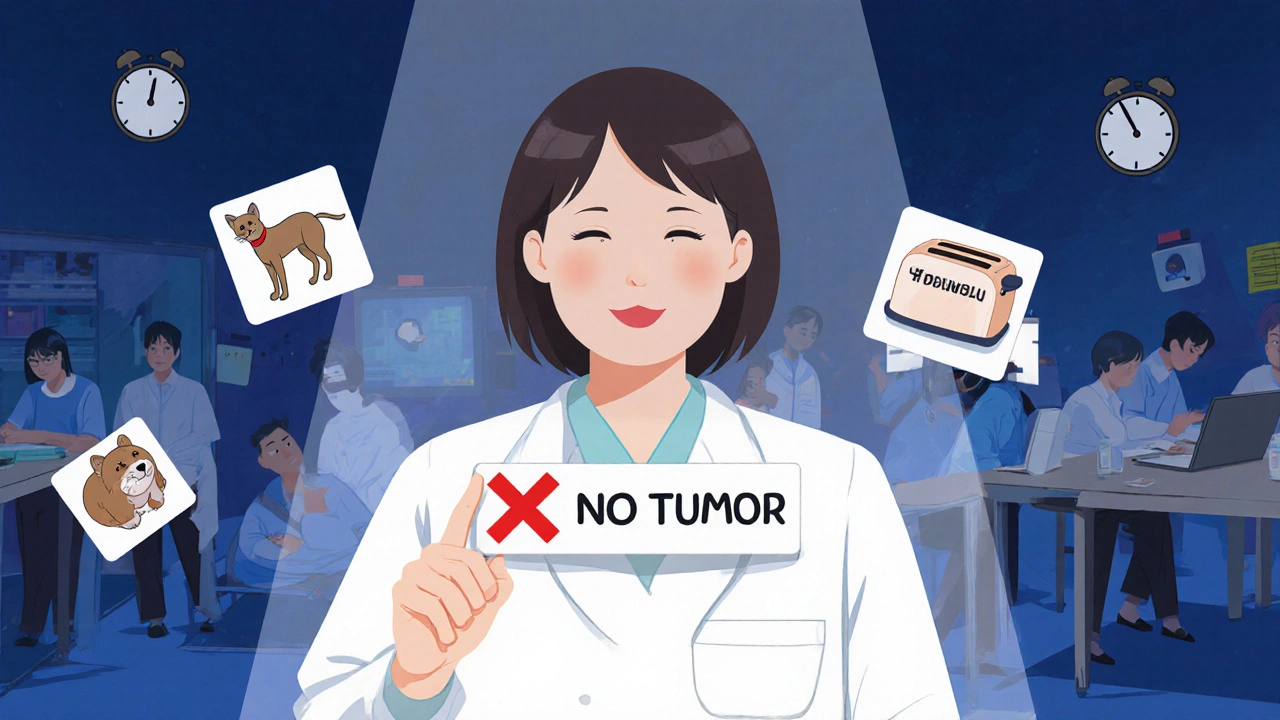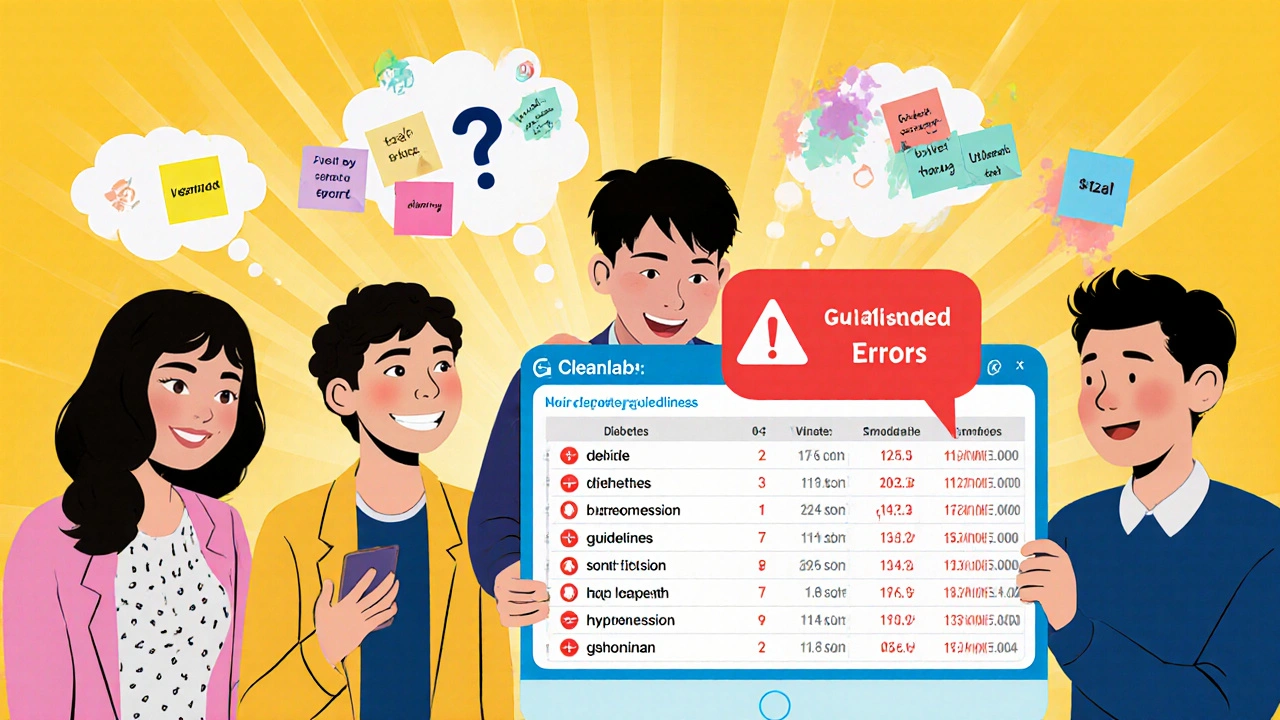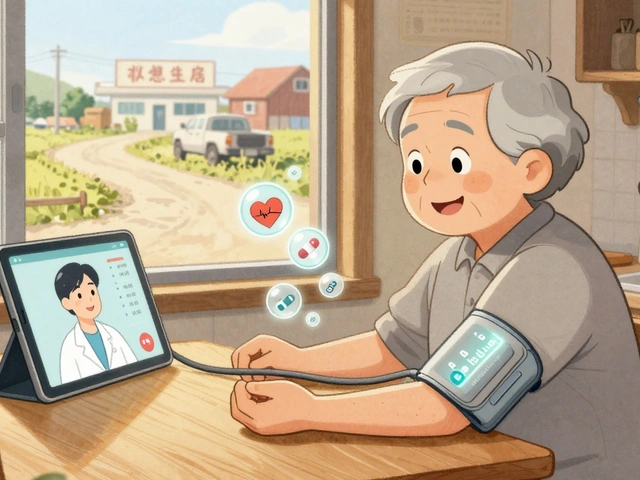
When you train a machine learning model, you’re not just feeding it data-you’re feeding it labels. These labels tell the model what to look for: is this a cat or a dog? Is this patient’s scan showing a tumor? Is this text about customer service or billing? If the labels are wrong, the model learns the wrong thing. And it doesn’t matter how fancy your algorithm is-if the ground truth is broken, your model will fail.
Studies show that even high-quality datasets like ImageNet have around 5.8% labeling errors. In real-world industrial projects, that number often climbs to 8-15%. In healthcare, autonomous driving, or legal document analysis, a single missed label can mean a life lost or a legal case ruined. Recognizing these errors isn’t optional-it’s the first step to building reliable AI.
What Labeling Errors Actually Look Like
Labeling errors aren’t just typos. They’re subtle, systematic, and often hidden in plain sight. Here are the most common types you’ll encounter:
- Missing labels: An object, entity, or class is completely ignored. In autonomous vehicle data, this could mean a pedestrian in the frame isn’t marked at all. This accounts for 32% of errors in object detection, according to Label Studio’s 2022 analysis.
- Incorrect boundaries: The box drawn around an object doesn’t fit it properly. A car might be labeled with a box that cuts off its bumper or includes part of the sidewalk. This happens in 27% of object detection cases.
- Wrong class assignment: A cat is labeled as a dog. A medical report labeled as "diabetes" actually describes hypertension. This makes up 33% of entity recognition errors, per MIT’s 2024 research.
- Ambiguous examples: The data could reasonably belong to more than one class. A product review saying "it’s okay, but not great"-is it neutral or negative? These confuse both humans and algorithms.
- Out-of-distribution samples: A photo of a toaster appears in a dataset labeled for "animals." It doesn’t belong, but it slipped through.
- Midstream tag additions: The annotation guidelines changed halfway through the project. Some images were labeled with 5 classes, others with 8. Version control was ignored.
These errors don’t come from laziness. They come from unclear instructions, time pressure, and lack of feedback loops. TEKLYNX found that 68% of labeling mistakes trace back to ambiguous guidelines. Fixing the label isn’t enough-you have to fix the process.
How to Spot These Errors Without a PhD
You don’t need to write code to find labeling errors. Here’s how to start:
- Run a simple model: Train a basic classifier-even a logistic regression-on your labeled data. Then look at the predictions it’s most confident about. If the model says "this is definitely a tumor" but the label says "no tumor," that’s a red flag. Encord’s research shows this catches 85% of errors if your model hits at least 75% accuracy.
- Use cleanlab: This open-source tool (version 2.4.0 as of 2023) uses confident learning to estimate which labels are most likely wrong. It doesn’t require you to understand the math. Just feed it your labels and model predictions. It outputs a ranked list: "These 120 examples are 92% likely to be mislabeled." You don’t have to trust the tool blindly-but you should trust its signal.
- Check for class imbalance: If 95% of your data is labeled "no disease," but your model keeps predicting "disease," you might have a labeling problem. Rare classes are often mislabeled because annotators assume they’re noise.
- Ask for a second pair of eyes: Have two or three annotators label the same 50 samples. If they disagree on more than 15%, your guidelines are too vague. Label Studio’s data shows that triple-annotator consensus cuts error rates by 63%.
- Look at the outliers: Sort your data by confidence score. The examples your model is least sure about are often the ones with the worst labels. These are your low-hanging fruit.
How to Ask for Corrections Without Burning Bridges
When you find a labeling error, your next move matters. You’re not accusing someone of being wrong-you’re helping them get better.
Here’s how to frame it:
- Don’t say: "This label is wrong. Fix it."
- Do say: "I noticed this example was labeled as ‘no tumor,’ but the scan shows a 3mm nodule in the left lobe. The guidelines say to mark any lesion over 2mm. Could we double-check this one?"
Always anchor your feedback in the guidelines. If the guideline says "label all lesions over 2mm," and the annotator missed one, it’s not a personal failure-it’s a guideline clarity issue. Document that. Update the guide. Share it with the team.
If you’re using a tool like Argilla or Datasaur, use the built-in comment feature. Tag the specific annotation, explain why you think it’s wrong, and suggest the correct label. This creates a traceable audit trail. TEKLYNX found that teams with audit logs fix errors 40% faster because they can trace patterns back to training gaps.
For high-stakes domains like healthcare or autonomous systems, never rely on a single correction. Use a review panel. If a label is flagged as wrong, have two domain experts review it independently. If they agree, update it. If they disagree, flag it for a senior annotator or medical reviewer. This reduces false corrections.

Tools That Actually Help (And Which to Avoid)
Not all tools are created equal. Here’s what works today:
| Tool | Best For | Limitations | Learning Curve |
|---|---|---|---|
| cleanlab | Statistical accuracy, research, text and image classification | Requires Python, struggles with class imbalance >10:1 | High (8+ hours training) |
| Argilla | Team collaboration, Hugging Face integration, user-friendly UI | Weak on multi-label tasks with >20 classes | Low (1-2 hours) |
| Datasaur | Enterprise annotation teams, tabular and text data | No object detection support | Low (integrated into workflow) |
| Encord Active | Computer vision, medical imaging | Needs 16GB+ RAM, slow on large datasets | Moderate |
For most teams, start with Argilla if you’re working with text or images and need collaboration. Use cleanlab if you’re technical and want the most statistically sound detection. Avoid tools that don’t let you trace corrections back to the original annotator or guideline. Without that, you’re just moving noise around.
What Happens When You Don’t Fix Labeling Errors
Let’s say you ignore 10% of labeling errors in a medical diagnosis model. That might sound small. But here’s what it actually means:
- False negatives rise by 18-25% (MIT, 2024)
- Model accuracy drops by 1.5-3%-even if you double the model size
- Regulators like the FDA will reject your submission
- Doctors stop trusting the system
Curtis Northcutt, who created cleanlab, says correcting just 5% of label errors in CIFAR-10 improved accuracy by 1.8%. That’s more than most model tweaks achieve. And Professor Aleksander Madry at MIT says: "No amount of model complexity can overcome bad labels."
On the flip side, teams that build label correction into their workflow see 20-30% higher model accuracy than those who don’t, according to Gartner. This isn’t a nice-to-have. It’s the difference between a product that works and one that gets shelved.

How to Build a Sustainable Correction Process
Fixing labels once isn’t enough. You need a system:
- Start with clear guidelines: Include 5-10 annotated examples for every label. Show what’s right and what’s wrong. TEKLYNX found this cuts errors by 47%.
- Version your guidelines: Every change to the labeling rules gets a new version number. Annotators must review the latest version before starting work.
- Run weekly error audits: Pick 100 random samples. Run them through cleanlab or a simple model. Track which error types appear most often. Use that to update training.
- Feedback loops matter: Annotators should see how their labels affect the model. Show them: "Your labels helped reduce false alarms by 12% this week." Recognition improves quality faster than punishment.
- Document everything: Use a shared log: "Error type: missing label. Cause: guideline didn’t specify to label partial objects. Fix: updated guideline v3.1, retrained annotators."
This isn’t about perfection. It’s about progress. Every time you catch and fix a label, you’re not just cleaning data-you’re teaching the model to be smarter.
What’s Next for Labeling Quality
The field is moving fast. By 2026, Gartner predicts every enterprise annotation tool will have built-in error detection. Cleanlab’s next release (Q1 2024) will specialize in medical imaging, where error rates are 38% higher than in general datasets. Argilla is integrating with Snorkel to let teams write rules like: "If the text contains ‘suspicious mass’ and ‘biopsy recommended,’ it must be labeled ‘malignant’-override if contradicted by radiologist notes."
But the biggest shift? The move from correcting labels to preventing them. MIT is testing "error-aware active learning," where the system asks humans to label only the examples most likely to be wrong. That cuts correction time by 25%.
The message is clear: data quality isn’t a step in the pipeline. It’s the foundation. And if you’re not checking your labels, you’re not building AI-you’re building noise.
How common are labeling errors in machine learning datasets?
Labeling errors are extremely common. Even high-quality datasets like ImageNet contain about 5.8% errors. In commercial projects, error rates typically range from 3% to 15%, with computer vision datasets averaging 8.2%. In healthcare and safety-critical fields, errors can be higher due to complexity and ambiguity.
Can I fix labeling errors without coding?
Yes. Tools like Argilla and Datasaur offer web-based interfaces where you can upload your data, run automated error detection, and correct labels with clicks. You don’t need to write code-you just need to understand your data and guidelines. For more advanced detection, cleanlab requires Python, but its output can be reviewed in a simple list format.
What’s the biggest mistake people make when correcting labels?
The biggest mistake is correcting labels without updating the guidelines. If three annotators miss the same type of label, it’s not their fault-it’s your instructions. Fix the rule, not just the label. Otherwise, the same error will keep coming back.
Do I need to retrain my model after correcting labels?
Yes. Model performance is tied directly to the quality of the training data. After correcting even a small number of labels-especially if they were misclassified or missing-you should retrain your model. A model trained on clean data will perform significantly better, even with the same architecture.
How do I convince my team to prioritize label quality?
Show them the impact. Run a quick test: train two models-one on the original data, one on corrected data. Compare their accuracy, precision, or false positive rates. If correcting 5% of labels improves accuracy by 1.5-2%, that’s a clear ROI. Use real numbers. Teams care about results, not theory.
Are labeling errors worse in some industries than others?
Yes. Healthcare, autonomous driving, and legal document analysis have higher stakes and more complex labels. Medical imaging has 38% higher error rates than general computer vision because tumors vary in shape, size, and visibility. In legal text, subtle wording differences change meaning. These fields need stricter guidelines, more reviews, and better tools.
14 Comments
Write a comment
More Articles

Deplumation Explained: Causes of Feather Loss in Birds and How to Help
Why birds lose feathers and what to do. Learn the science of deplumation, key causes, red flags, and a step-by-step plan to diagnose, treat, and prevent.

Breakthrough Restless Legs Syndrome Treatments in 2025: Latest Hopes for Relief
2025 is showing real progress for people battling Restless Legs Syndrome. Cutting-edge drugs and exciting non-drug therapies are giving new hope. This article dives deep into the genuine breakthroughs—what's working, how UK patients are coping, and which emerging options you should know about. Find out about new medicines like amantadine and why lifestyle changes are getting attention from experts. Everything here is down-to-earth, practical, and aimed at helping real sufferers finally get some rest.

Telehealth Strategies for Monitoring Side Effects in Rural and Remote Patients
Telehealth is transforming how rural and remote patients manage medication side effects. From smart devices to pharmacist-led monitoring, discover how these strategies reduce hospitalizations and save lives in underserved areas.
Kaylee Crosby
November 26, 2025 AT 08:36Just wanted to say this post is gold. I’ve been in the trenches with medical labeling teams and the 38% error rate in imaging? Yeah, that’s real. We had a model that kept missing micro-aneurysms because the guidelines said ‘only label if >1.5mm’ but no one showed annotators what a 1.2mm one looked like. Added 5 examples, retrained, and false negatives dropped 22%. It’s not magic-it’s just paying attention.
Also, use Argilla. It’s dumb simple. No Python needed. Just click, fix, move on.